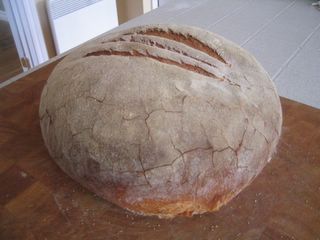I took the leap and made sourdough buckwheat pancakes for the family this morning, without a net. Frequent readers of F,NRS will recall that while my crew are all devoted
pancake eaters, I feared this more agressive cousin would turn them off. Well, never underestimate kids who prefer roquefort to processed singles!
Here's how John Thorne makes these in
Serious Pig:
- At T minus 24 hours, make the sponge. Put 3 tbsp all-purpose flour, 3 tbsp buckwheat flour, 6 tbsp warm water and 1/4 tsp active dry yeast in a small bowl. Stir, cover with plastic wrap and leave on the counter.
- At T minus 12 hours, mix 3/4 cup all-purpose flour and 3/4 cup buckwheat flour in a larger bowl. Whisk in 3/2 cups of warm water followed by the sponge. Cover with plastic wrap and leave out overnight.
- At T minus 2 minutes, add 3/2 tbsp molasses, 1/2 tsp baking soda and 1/4 tsp salt to the batter, stir and let rest while heating up a griddle. Lightly grease the griddle (bacon drippings, anyone?) initially and between batches.
- Cook the sourdough buckwheats and serve with maple syrup and butter or molasses or sorghum or...
Thorne mentions sage breakfast sausage as a great foil for the grassy, earthy taste of these cakes. I have no idea where one would buy such a creature, so I made some, following Daniel Pinard's guidelines in
Encore des pinardises: Recettes et propos culinaires:
- Mix a pound of lean ground pork with a generous tsp each of fine sea salt, chile pepper flakes and dried sage (or a tbsp of finely chopped fresh) and 1/4 cup of white wine.
- Form into patties (long, fairly flat ovals are nice).
- If you have the time, leave in the 'fridge for a few hours to let the flavours marry and the salt and wine work on the protein in the meat.
- Heat a frying pan over medium heat (no need to grease it) and fry up those sausages.
These aren't in
casings, but who cares? I don't want to hang them for smoking or drying, which is the main purpose of such packaging; I want to devour them posthaste. By the way, pork, salt and wine in the same proportions plus:
- 1 tbsp each fennel seeds and chopped fresh parsley, 1/2 tsp ground black pepper and 1/2 tsp chile pepper flakes gives you Sicilian sausage
- 2 cloves of garlic minced, 1 tbsp Hungarian paprika, 1 tsp cayenne pepper, a big pinch of ground cumin and one of ground coriander gives you chorizo (replace the pork with lamb and the coriander with ground cinnamon andcloves and you've got merguez)
(In the same chapter: Eat a raw oyster on the half shell, followed by a bite of warm homemade thyme sausage, then a bite of buttered bread and a big sip of white wine (preferably graves, otherwise muscadet, chablis or sancerre). Repeat twelve times in the company of good friends. Know then what it means to be happy. Raw oysters, you say? I guess this form of happiness will have to wait a few months, right friends?)
What a wonderful brunch! The only thing missing was baked beans...


